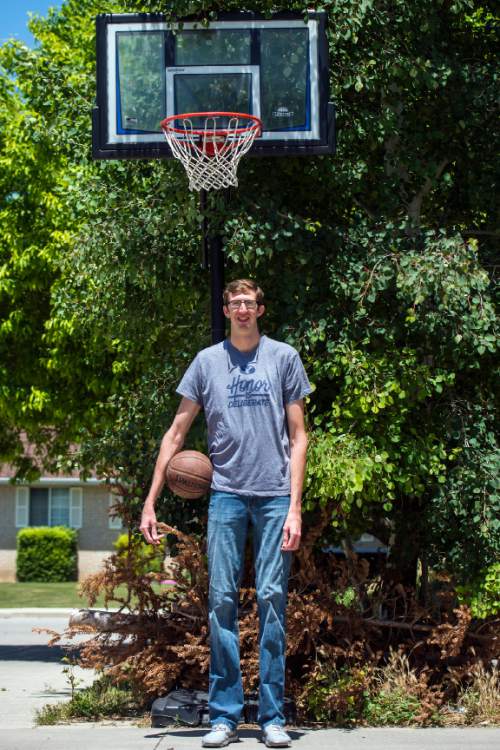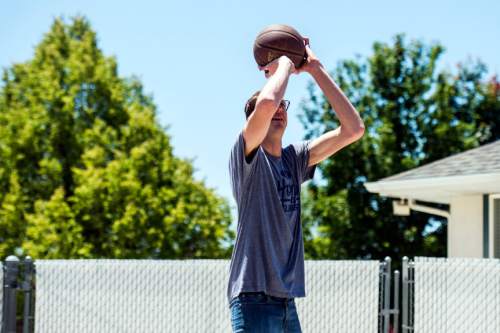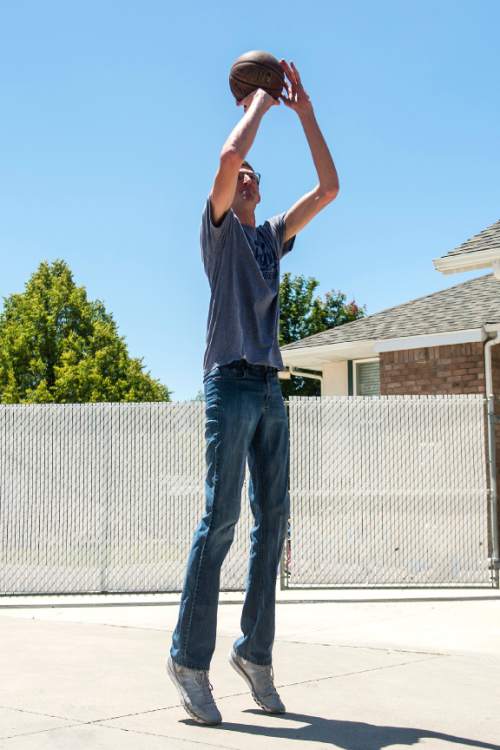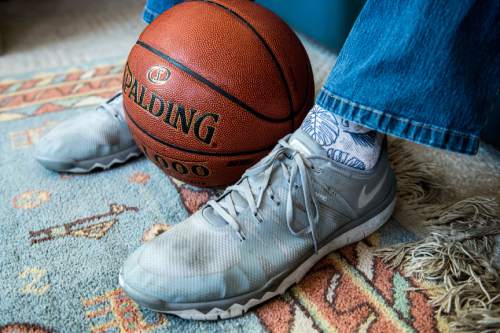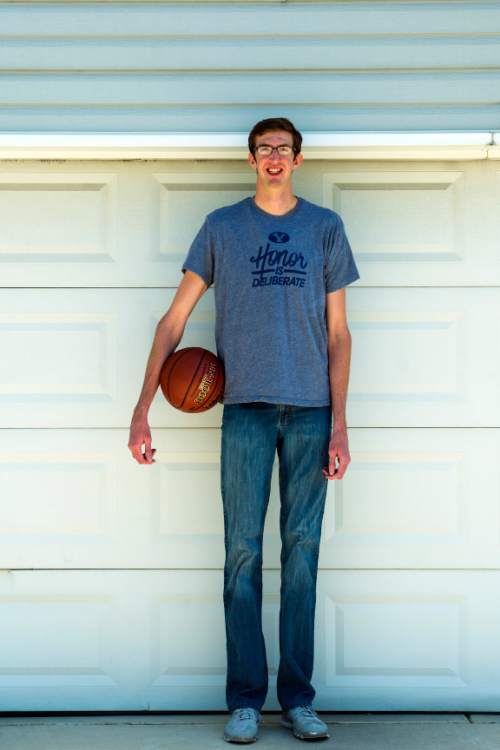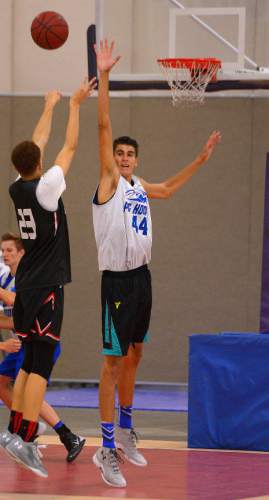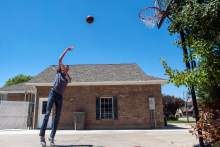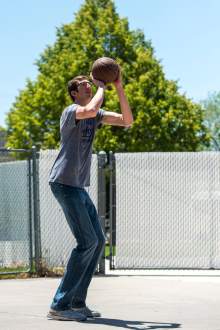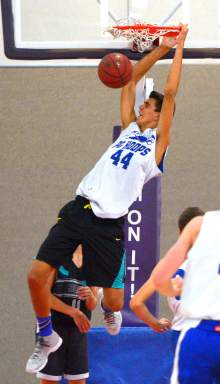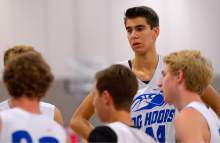This is an archived article that was published on sltrib.com in 2016, and information in the article may be outdated. It is provided only for personal research purposes and may not be reprinted.
Mark Eaton loves telling the story about the question he always hated hearing: Do you play basketball?
Eaton's life changed when a junior college coach approached him about the tiresome subject one day in the southern California tire store where he worked as an auto mechanic, then urged him to give basketball another try. Tom Lubin's prodding — after 15 visits and 14 rejections — eventually led Eaton to a 12-year career with the Jazz as one of the best defensive players in NBA history, while he fulfilled societal expectations for a 7-foot-4 person.
Anyone who's that tall is supposed to play basketball, right?
Asked if he always has been happy with his height, 7-3 Jazz center Tibor Pleiss was perplexed by the question. "It really helps me in the sport I love, so I don't want to be small," said the Germany native, who turned his face toward an imaginary sky above the practice court and joked, "The air is better, always above the clouds."
In "The BFG," Steven Spielberg's new movie, the big, friendly giant stands up to bigger bullies. In real life, side effects of being tall can include getting stuck in a car on Disneyland's Space Mountain ride, as happened to Alan Hamson, or being called "Freak" and "Lurch," as Eaton endured in high school. Other big issues for 7-footers are health problems related to height, fast-growing children being expected to act and learn at the level of older students and strangers who want to know how they tall are (former Jazz center Greg Ostertag likes to answer, "Five-foot-twenty-six") and if they play basketball.
"It took me a long time to get comfortable with myself," Eaton said in a recent interview, following one of the dozens of corporate presentations he delivers annually. "You're center stage all the time, the minute you walk out the door. … The hardest part is having an expectation placed on you [about basketball] that you didn't put on yourself."
The continual questions have some factual basis, considering 17 percent of 7-footers living in the United States will play in the NBA at some point, according to the book "The Sports Gene." Kevin Nixon, whose AAU team of 15-year-old Utahns includes 7-4 sophomore Matt Van Komen of Pleasant Grove High School, said, "I could see him playing in the NBA. … I'd actually be more surprised if eventually he didn't make it."
Growing pains
Expecting anyone to become another Shawn Bradley is asking a lot, though. Only three of 33 former players 7 feet or taller on the all-time rosters of Utah college programs have reached the NBA, and two were international players — Australia's Andrew Bogut and Austria's Jakob Poeltl, both from the University of Utah. The 7-6 Bradley, who grew up in the central Utah town of Castle Dale, is the American exception, having played nine years in the NBA after spending one season at BYU.
Bradley grew 3 inches per year after kindergarten, when he already was so tall that Emery High School's basketball coach begged his parents to stay in town. Although he weighed only 185 pounds as a 7-4 junior, Bradley had grown so steadily that he was coordinated enough to run up and down the court, play baseball and golf and even dabble in football.
Van Komen's growth spurt came early — in his second month. He added 9 inches, doubled his weight to 20 pounds and "just never stopped from there," said his father, Troy. His mother, who played basketball for BYU, is 6-1; his father, who primarily has raised him since he was 2, stands 6-5.
On his way to 6-7 by sixth grade, Van Komen struggled in elementary school, by his father's account, with teachers expecting him to behave like an older child and other children unable to relate to him. He blended in better in junior high and is uncomfortable with his height only "in the halls, just looking over everybody," he said.
Van Komen is gaining confidence on the court, although his father said, "Sometimes I think he doesn't realize how tall he is and how dominating he can be."
He's getting there. "Swattin' people" is his favorite thing, he said, and he's known to waggle his finger after blocking a shot, more out of playfulness than arrogance. Van Komen is good-natured, but he's "not like that in games," he said, confirming a story of fighting back against players who tried to bully the 205-pounder during a recent University of Utah camp.
"He's always a marked guy," said Lynn Lloyd, his AAU club director.
Opponents of the Exum Elite 2019 team are surprised by Van Komen's ability to run, figuring they should beat him down the court. Offensively, he has gone from having trouble catching the ball to learning multiple moves in the post from Pleasant Grove coach Randy McAllister. "We need to do a better job of getting him the ball, because he has developed his game," said Nixon, whose No. 7-ranked team in the 15-year-old age group will play in tournaments this month in South Carolina, California and Las Vegas.
Van Komen averaged 16 points, eight rebounds and three blocks for Pleasant Grove's JV team and played regularly for the varsity as a freshman reserve. McAllister looks forward to working with him for three more reasons, observing, "His height won't ever take a night off." McAllister benefits from having coached Alan Hamson, who stood 7 feet as a senior in 2012 — before surgery to correct curvature of his spine stretched him to 7-3 and alleviated the "awful" pain he'd played through, Hamson said.
Back problems sidelined Eaton during what would have been his 12th season with the Jazz, then forced him to retire in 1994. At 59, he's healthy enough to ski about 40 days a year. Other centers his age have died in the past year, including former Jazz teammate Darryl Dawkins and Moses Malone, who began his pro career with the Utah Stars of the ABA.
"It's risky to be a big guy over 50," said Eaton, who intends to share advice about heart maintenance during a National Basketball Retired Players Association meeting this month in Las Vegas.
"It's definitely a big discussion point with the organization," said former Jazz forward Thurl Bailey, the NBRPA chairman. "We need to keep the awareness out there, so they understand what they have to do to prolong their lives."
In ESPN Magazine, the 6-9 Larry Bird said, "I tell my wife all the time, 'You don't see many 7-footers walking around at the age of 75.' "
Margo Dydek, a 7-2 center who played for the Utah Starzz of the WNBA from 1998-2002, died of a heart attack at age 37, while pregnant with her third child.
'Know your job'
The Hamsons of Lindon, possibly the world's tallest family (although they're not interested in pursuing that distinction), don't live in fear of such future complications of their height. Yet health problems already have affected Alan and his younger brother, Timothy, who's 7-2.
Those medical issues are former BYU basketball star Tresa Spaulding Hamson's only regrets about having tall children. She and her husband, David, stand 6-7, as do daughters Jennifer, a BYU All-America basketball and volleyball athlete who plays pro basketball internationally, and Sara, who's committed to play both sports for BYU after her Pleasant Grove career. Their youngest child, Heather, is 5-7 at age 12.
"One of the things that I've always taught my children is to embrace who you are," Tresa Hamson said. "When you're an athlete, it's usually easier — you're more accepted in the athletic world because you're tall."
Timothy tried basketball before pursuing musical interests. Alan joined BYU's basketball team as a walk-on last season and showed signs of development on the scout team in practice — "I blocked almost everyone at least once," he said — before injuring his knee in February. He's no longer on BYU's roster but may serve as a practice player this year, while he considers transferring and playing somewhere.
Either way, he'll follow his father into the computer science field. David Hamson's hobby is walking behind his children, gauging people's reactions to them. The family's posing in Times Square once turned into a major photo opportunity for other tourists, and the Hamsons were so besieged with requests in Las Vegas that an apologetic hotel manager gave them tickets to attractions. "We try to be as nice as possible," Tresa Hamson said. "For everyone else, it's such a big deal."
Capitalizing on the preoccupation with his height that once made him avoid people, Eaton offers a personal photo and autograph opportunity in marketing himself as a corporate speaker. In a presentation to Tesoro refinery managers at Deer Valley, Eaton showed "the only action shot I could find for my high school career." He's standing behind his teammates in a timeout huddle. He grew to hate basketball, saying, "I had failed at the one thing everyone believed I could do."
Eaton said his motivation to attend a trade school in Arizona and become a mechanic was simple: "I chose this; this is something I wanted to do," he said, in contrast to being expected to play basketball.
But Lubin got him back into the gym, launching Eaton's successful career at Cypress Junior College and earning him a scholarship to UCLA. Although Eaton played only 41 total minutes for the Bruins as a senior, a brief conversation with the legendary Wilt Chamberlain altered his approach to basketball. As Eaton rested during a summer pickup game at UCLA, Chamberlain tapped his shoulder and said, "Let me show you what your job is," guarding the basket.
Eaton embraced that advice, establishing an NBA season record for blocked shots that still stands, more than 30 years later, and becoming a two-time NBA Defensive Player of the Year. And Lubin's summary of the four aspects of Eaton's game that distinguished him — "Know your job," "Do what you're asked to do," "Make people look good" and "Protect others" — frames Eaton's corporate presentation.
It makes great material, how he went from auto mechanic to an NBA All-Star whose No. 53 jersey was retired by the Jazz, all because a junior college assistant coach spotted a tall guy while driving past a tire store. In his speech, Eaton summarizes his pro career as "a miracle that I didn't really want to be a part of."
Twitter: @tribkurt —
Utah's all-time 7-foot list
Player Height Years
Utah
David Cecil 7-0 1982-83
Cameron Koford 7-0 2000-02
Andrew Bogut 7-0 2003-05
Luke Nevill 7-1 2005-09
David Foster 7-3 2006-13
Jason Washburn 7-0 2008-13
Dallin Bachynski 7-0 2012-15
Jakob Poeltl 7-0 2014-16
Jayce Johnson 7-0 2015-16
Weber State
Richard Smith 7-1 1976-80
Shawn Campbell 7-1 1984-86
Gordon Schmidt 7-0 1985-86
Cameron Koford 7-1 1997-98
Utah State
Larry Bunce 7-0 1966-67
Ed Gregg 7-0 1973-76
Leo Cunningham 7-0 1981-82
Nathan Wickizer 7-0 1991-95
Larrell Redic 7-0 1996-97
Anthony Diloreto 7-1 2009-10
Leland Miller 7-1 2010-11
Carson Shanks 7-0 2013-14
Bilal Begic 7-1 2014-15
BYU
Fred Petty 7-1 1971-72
Steve Lackey 7-0 1971-73
Paul Vos 7-0 1977-78
Dave McGuire 7-0 1977-81
Carl Pollard 7-2 1983-85
Shawn Bradley 7-6 1990-91
David Anderson 7-0 1996-97
Dan Howard 7-0 1999-2003
Alan Hamson 7-3 2015-16
Southern Utah
Bob Evans 7-1 1983-84
Carl Pollard 7-3 1989-90
Nate Bloom 7-0 1999-2000
Brad Kanis 7-2 2006-07
Dallin Bachynski 7-0 2009-10
Utah Jazz
Brett Vroman 7-0 1980-81
Rich Kelley 7-0 1982-85
Mark Eaton 7-4 1982-93
Steve Hayes 7-0 1985-86
Walter Palmer 7-2 1990-91
James Donaldson 7-2 1992-95
Luther Wright 7-2 1993-94
Felton Spencer 7-0 1993-96
Greg Ostertag 7-2 1995-2004, '05-06
Olden Polynice 7-0 1999-2001
Curtis Borchardt 7-0 2002-05
Paul Grant 7-0 2003-04
Mikki Moore 7-0 2003-04
Aleksander Radojevic 7-3 2004-05
Kyrylo Fesenko 7-1 2007-11
Kosta Koufos 7-0 2008-11
Francisco Elson 7-0 2010-11
Andris Biedrins 7-0 2013-14
Rudy Gobert 7-1 2013-16
Tibor Pleiss 7-3 2015-16
Jeff Withey 7-0 2015-16



